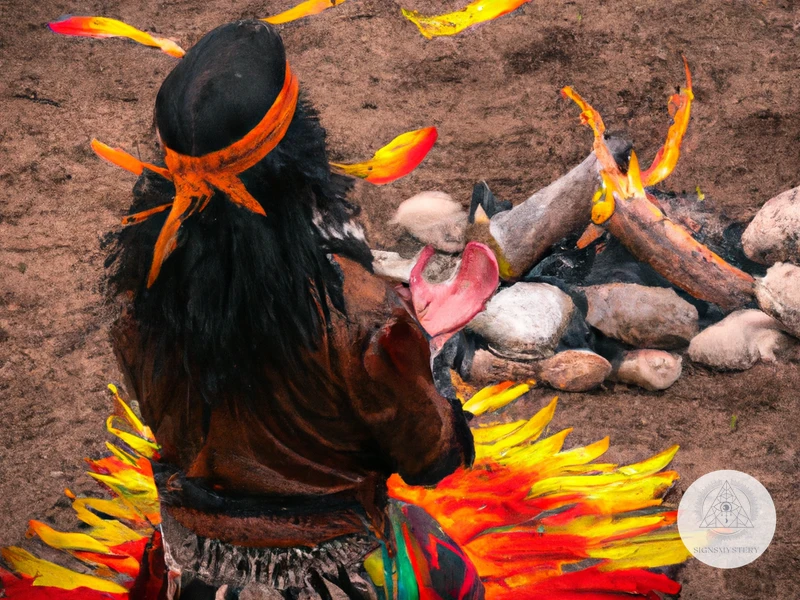Humans have been turning to alternative methods of healing for centuries, with shamanism being one of the oldest and most fascinating practices. There is a certain mystique surrounding shamanism, with its connection to spirits, nature, and ancient traditions. But what exactly is shamanism, and what role does it play in healing? In this article, we’ll delve into the world of shamanism and explore its various practices and benefits. We’ll also take a look at alternative healing methods inspired by shamanism, as well as some of the controversies and ethical considerations surrounding this ancient practice. Join us as we embark on a journey into the fascinating world of shamanism and its relationship with healing.
What is Shamanism?

Shamanism is a spiritual and healing practice that has been around for thousands of years. It is a belief system that is deeply rooted in the connection between humans and nature, as well as the relationship between the spiritual and physical worlds. At its core, shamanism involves a shaman, who is a person who acts as a mediator between the spiritual and physical realms. They use a variety of traditional methods and practices to help individuals, communities, and even the environment heal. Shamanism takes many different forms, depending on the culture in which it is practiced. To learn more about the evolution and origins of shamanism, check out this article.
Defining Shamanism
Shamanism is a spiritual practice rooted in the belief that everything in nature is connected and has a spirit. The word “shaman” originates from the language of the Tungus people in Siberia and refers to a person who has the ability to enter altered states of consciousness to communicate with the spiritual realm.
Shamanism often involves healing practices, divination, and rituals aimed at maintaining a harmonious relationship between humans and the natural world. Many different cultures have their own unique interpretations of shamanism and its practices, but common themes include a belief in the power of nature, the importance of community, and the role of spirituality in everyday life.
The practice of shamanism dates back thousands of years and has been found in many ancient civilizations, including the indigenous peoples of North and South America, Africa, and Asia. Despite its ancient roots, shamanism continues to be practiced around the world today, both in traditional contexts and in modern adaptations.
In shamanic practice, a shaman serves as a mediator between the visible world and the spirit world. They may use a variety of techniques, such as trance-like states, music, or movement to enter altered states of consciousness and communicate with the spirits. Shamans may also use tools such as drums, rattles, or feathers to facilitate their connection with the spiritual realm.
Shamanism is a complex and multifaceted spiritual practice that reflects a deep relationship between humans and nature. Its roots in ancient civilizations and continued relevance in contemporary society demonstrate the enduring power and significance of shamanic traditions.
Shamanism in Different Cultures
Shamanism is a practice that has existed across a wide range of cultures throughout history. The role of shamans as intermediaries between the physical and spiritual worlds has been recognized as an important aspect of many societies for hundreds of years. Some examples of shamanism across different cultures include:
- Eastern Europe and Russia: In this region, shamans were known as “volkhvy” or “chuma” and were revered for their ability to communicate with spirits and deities.
- North America: Native American tribes in the United States and Canada have a long history of shamanic practice, with different tribes referring to their shamans with names such as “mediwin” and “shideh.” Shamans in these cultures play a crucial role in healing, guiding spiritual practices, and communicating with the spirit world.
- South America: Indigenous cultures in South America, particularly in the Amazon region, have a rich shamanic tradition that incorporates the use of “plant medicines” such as ayahuasca. Shamans in these cultures are often referred to as “curanderos” or “ayahuasqueros.”
- Africa: Shamanism in Africa varies depending on the culture, with some groups focusing on the ability to communicate with ancestors and others using shamanic practices in healing rituals. Shamans in African cultures are often referred to as “sangomas” or “witch doctors.”
It is important to note that while the practice of shamanism may vary in different cultures, the underlying principles of connecting with the spiritual world and using that connection to heal and guide others remain consistent. To learn more about shamanism across cultures, check out our article on shamanism around the world.
Shamanism and Healing
Shamanism is a traditional healing practice that has been used for centuries by Indigenous cultures around the world. Its approach to healing is holistic, encompassing physical, emotional, and spiritual aspects of the individual. Shamanic Healing Practices involve rituals such as song, dance, and the use of natural remedies. Shamans play a vital role in these practices, as they act as a mediator between the physical and spiritual worlds. They use their connection to nature and spiritual guides to restore balance and harmony to their patients. This approach to healing has proven to be effective in treating a wide range of illnesses, including mental health disorders and physical ailments. As society continues to recognize the benefits of traditional healing practices, shamanism is experiencing a revival in contemporary society.
Shamanic Healing Practices
involve the shaman entering a trance state through a variety of techniques, such as drumming, chanting, or dancing. Once in this state, the shaman is believed to communicate with spirits or energies that can bring about healing for the person or group seeking treatment. This type of healing can be used for physical, emotional, or spiritual ailments.
One of the most traditional shamanic healing practices is soul retrieval. This involves the shaman journeying into the spirit realm to retrieve lost parts of a person’s soul. According to shamanic belief, when we experience trauma or a difficult event, a piece of our soul may splinter off and become lost. This can lead to feelings of emptiness, depression, or disconnection. Soul retrieval aims to bring back these lost parts and reintegrate them into the person’s being, restoring balance and well-being.
Another shamanic healing practice is energy clearing. The shaman may use tools such as feathers, stones, or rattles to clear negative energy from a person’s energy field. This can involve removing entities or attachments that are causing harm, or simply clearing away stagnant or dense energy. The goal of energy clearing is to create a more positive and balanced energy field, which can improve physical and emotional health.
Shamans may also use the power of plants in their healing practices. This can involve working with medicinal plants, such as using herbs or essential oils to treat physical ailments. But it can also involve working with plant spirits for emotional or spiritual healing. For example, a shaman may lead a person on a guided journey to meet with the spirit of a plant that can offer wisdom or healing energy.
Shamanic healing practices can be a powerful way to address physical, emotional, and spiritual imbalances. They offer a unique perspective on healing that is rooted in ancient wisdom and a deep connection to nature and spirit. However, it’s important to work with a trained and experienced shaman who operates with integrity and respect for cultural traditions.
The Role of a Shaman in Healing
Shamans play a vital role in traditional healing practices. They act as a mediator between the physical world and the spiritual world, channeling healing energy and wisdom to those in need. Here is a breakdown of the different roles a shaman may play in the healing process:
| Role | Description |
|---|---|
| Diagnosis | A shaman may use various methods, such as divination or psychic abilities, to determine the cause of an individual’s illness or ailment. They may then relay this information to the individual and their community. |
| Treatment | After the diagnosis, the shaman will determine the appropriate treatment for the individual. This may include the use of herbal remedies, spiritual practices, or even physical interventions such as massage or acupuncture. |
| Energy Healing | Shamans are known for their ability to channel healing energy from the spiritual realm to the physical realm. They may use various techniques, such as drumming or chanting, to enter a trance state and access this energy. |
| Facilitation | A shaman may act as a facilitator between an individual and their spirit guides or ancestors. They can help individuals connect with their inner wisdom and spiritual support system, allowing for healing and personal growth. |
Shamans also play a crucial role in supporting their community’s overall health and well-being. They may perform ceremonies and rituals to honor the land and the spirits of the natural world, which can help to maintain balance and harmony in the community. Additionally, they may provide guidance and counseling to individuals or groups who are struggling with emotional or spiritual issues.
The role of a shaman in healing is multifaceted and complex, blending traditional wisdom with spiritual insight and energy healing practices. By working with a shaman, individuals can access a deeper level of healing that addresses not only physical symptoms, but also the spiritual and emotional roots of their health concerns.
Internal link: The Relationship Between Shamanism and Spirituality
The Benefits of Shamanism in Modern Healing

Shamanism has many benefits that can be applied to modern healing practices. One of the greatest benefits is the focus on holistic healing that involves both physical and spiritual aspects. Shamanic healing practices often involve introspection, meditation, and emotional release, which can be effective in treating mental health issues. Additionally, the use of natural remedies and plants in shamanic healing can be a more sustainable and eco-friendly alternative to traditional medicine. Crystal and sound healing, inspired by shamanism, have gained popularity in recent years for their ability to promote relaxation and reduce stress. Shamanism can also be beneficial in promoting cultural awareness and diversity in the healthcare industry. By embracing traditional healing methods, which have been used for centuries in various cultures, we can broaden our understanding of health and wellness.
Shamanism and Mental Health
Shamanism has been used for thousands of years to promote mental and emotional healing. The ancient practice aims to heal the whole person, including their mental, emotional, and spiritual sides. Shamans have been known to use trance-like states and various rituals to access the spiritual world and connect with their patients on a deeper level.
One example of a shamanic practice that has been used for mental health is soul retrieval. This involves the shaman entering a trance-like state to communicate with their patient’s lost soul parts and retrieve them. This is done to restore balance and wholeness to the person’s soul and can be beneficial for those who have experienced trauma or emotional difficulties.
Another shamanic practice that has been used for mental health is plant medicine. Certain plants contain psychoactive compounds that are believed to have therapeutic effects. For example, the use of the Amazonian plant Ayahuasca in shamanic ceremonies has been linked to improved mental health outcomes in some cases. Some studies have suggested that Ayahuasca can improve participants’ well-being, reduce symptoms of depression and anxiety, and increase feelings of connectedness.
Despite the promising benefits of shamanism for mental health, it is important to note that the practice should not be seen as a replacement for traditional mental health treatments. It is important to consult a qualified mental health provider when struggling with mental health issues. However, incorporating shamanic practices into a holistic treatment plan may be beneficial for some individuals.
Shamanism can play a significant role in promoting mental and emotional well-being. With its emphasis on spirituality and connection to nature, shamanism can offer unique benefits for those seeking to heal the mind and soul. However, it is essential to be mindful of cultural appropriation and seek guidance from trained professionals when incorporating shamanic practices into a wellness routine.
Shamanism and Physical Health
Shamanism has been known to have a significant effect on physical health. Shamans believe that physical illness is caused by spiritual disharmony, and they use various techniques to restore balance to the body. They use herbal medicine and perform rituals to help the body heal itself.
One of the primary ways in which shamanism affects physical health is through energy healing. Shamans use their spiritual connection to the universe to balance a person’s energy field. By doing this, they can help remove blockages that are causing pain or illness. This idea is similar to the practice of acupuncture, which aims to restore balance to the body’s energy channels.
Shamanism also promotes the use of herbs and plants for physical healing. Shamanic healers use plants to create teas, ointments, and salves that can be applied topically or ingested to treat everything from headaches to infections. Plants hold a significant place in shamanism, and each one has its own specific healing properties and spiritual associations.
Additionally, shamanic rituals often involve fasting and purging, which can have a profound effect on physical health. Fasting allows the body to rest and detoxify, while purging removes toxins that have built up in the system. These practices can lead to greater physical well-being and increased longevity.
It is important to note that shamanism is not a replacement for modern medicine. Rather, it is a complement to it. Shamanism can be used in conjunction with medical treatments to promote healing and improve outcomes.
Shamanism’s focus on spiritual and energetic healing can have a profound impact on physical health. As we continue to explore and embrace traditional healing practices, we may find that shamanism holds valuable insights into how to promote health and wellness in our modern world.
Alternative Methods Inspired by Shamanism
There are several alternative healing methods that draw inspiration from shamanism. Crystal and sound healing are two popular examples. Both practices involve using vibrations to alter a person’s physical and emotional state. Crystal healers often place crystals on or around the body, allowing their energy to interact with the person’s energy field. Sound healers use instruments like singing bowls or gongs to create vibrations that resonate with the body. Another alternative method inspired by shamanism is plant medicine and ayahuasca. Ayahuasca is a hallucinogenic brew used in shamanic ceremonies in South America. It’s believed to offer profound spiritual healing, and some people report significant improvements in their mental health after using it. However, it’s important to note that ayahuasca can have serious physical and psychological risks and should only be used under the guidance of a trained practitioner. These alternative methods offer a glimpse into the diverse world of shamanic healing and its potential benefits.
Crystal and Sound Healing
are alternative healing methods inspired by Shamanism. Both practices involve the use of natural materials such as crystals, gongs, singing bowls, and other instruments to promote relaxation and healing.
Crystal healing is based on the idea that crystals contain unique energetic properties that can positively affect the human body and mind. Practitioners of crystal healing use different types of crystals, such as amethyst, to promote relaxation, reduce stress, and to help improve various physical ailments. This practice involves placing crystals on different parts of the body or using them to create a crystal grid. The use of crystals is also believed to enhance meditation practices, promote mental clarity, and increase intuition.
Sound healing is an ancient practice that involves
Subscribe to Our Newsletter
Sign up to receive the latest news and updates.
While the effectiveness of crystal and sound healing is still debated, many individuals have found these alternative therapies to be helpful in promoting relaxation and reducing stress. They are often used in conjunction with traditional Western medicine to provide additional support for individuals dealing with chronic pain, anxiety, depression, and other health issues.
It’s important to note that the practice of crystal and sound healing should be approached with caution. It is recommended that individuals only see reputable practitioners and consult with their healthcare provider before starting any alternative therapy. While these practices have been used for centuries, more scientific research is needed to fully understand their effectiveness and possible side effects.
Crystal and sound healing provide individuals with alternative paths to healing and relaxation, and are inspired by the ancient practice of Shamanism.
Plant Medicine and Ayahuasca
Plant medicine has been used for medicinal and spiritual purposes by indigenous cultures for centuries. Ayahuasca, in particular, is a brew made from several plants native to the Amazon basin and has gained popularity as a shamanic medicine. It contains DMT, a psychoactive compound that induces intense spiritual experiences and is often used for healing purposes.
In shamanic traditions, the shaman is said to use plant medicine to access otherworldly realms and bring back information and knowledge that can be used to heal others. Ayahuasca is believed to have the ability to heal physical, emotional, and spiritual ailments by removing negative energy and promoting a sense of connection with the universe.
However, the use of Ayahuasca has also been met with controversy due to its potentially dangerous effects when not used under the guidance of an experienced shaman. Side effects can include vomiting, diarrhea, and intense psychological distress. For this reason, some countries have banned the use of Ayahuasca, while others only allow it to be used in a controlled setting with a licensed shaman.
Despite these concerns, many people have found Ayahuasca and other plant medicines to be transformative and life-changing experiences. They report improved mental health, increased feelings of well-being, and a deeper sense of connection with themselves and the world around them.
It’s important to note that the use of plant medicine should only be done under the guidance of a trained and experienced shaman to ensure the safety and well-being of the participant. It’s also important to approach shamanism with respect and understanding of its cultural significance and not appropriate or misrepresent the traditions and beliefs of indigenous cultures for personal gain.
Controversies Surrounding Shamanism
The topic of controversies surrounding shamanism is a complex one with various viewpoints. Cultural appropriation and misrepresentation are issues that arise when non-indigenous people practice shamanic traditions without understanding their cultural context. It’s important to note that the practice of shamanism in indigenous cultures is typically deeply rooted in spirituality and communal practices, not just individual healing. Additionally, the lack of proper training and understanding of the cultural context can result in harm to both the practitioner and the community. The ethics of shamanic healing is another controversy that arises as there is often no regulation or certification process for shamanic practitioners. This can lead to exploitation and harm towards vulnerable individuals seeking healing. It’s essential for practitioners to prioritize informed consent, cultural awareness, and ethical decision-making in their practice.
Cultural Appropriation and Misrepresentation
The issue of cultural appropriation and misrepresentation is a controversial subject in the world of shamanism. Unfortunately, the spiritual practices and beliefs of indigenous cultures have been appropriated and exploited for personal gain by outsiders who lack the necessary knowledge and understanding. In many cases, this has led to a misrepresentation of shamanism and its practices, leading to a misunderstanding of its true significance.
It is important to recognize that shamanism is deeply rooted in the cultural traditions and beliefs of indigenous peoples, and therefore must be respected as such. This means that individuals who wish to incorporate shamanic practices into their healing must do so in a way that honors the teachings and wisdom of the indigenous cultures.
Misrepresentation of shamanism can lead to harmful consequences, both for those seeking healing and for the indigenous communities from which these practices originate. It is imperative to avoid commercializing shamanic practices or cultural artifacts, as this only serves to perpetuate the exploitation of indigenous cultures.
It is important to acknowledge that cultural appropriation can have negative effects on the mental and spiritual well-being of indigenous people. The theft and exploitation of cultural practices can be deeply hurtful and perpetuate a cycle of cultural erasure that ultimately harms communities.
In closing, it is important to approach shamanism and its practices with the utmost respect and care. This means acknowledging the cultural significance of these practices and committing to incorporating them in a way that honors the teachings and wisdom of indigenous peoples. Only by doing so can we truly embrace the beauty and power of shamanism as a healing practice.
The Ethics of Shamanic Healing
The Ethics of Shamanic Healing:
Shamanism has roots in various cultures and traditions, and as such, it is important to approach shamanic healing practices with respect and consideration for the cultures from which they originated. There are important ethical considerations that both practitioners and patients should be aware of.
One major concern is cultural appropriation and misrepresentation. It is important for practitioners to acknowledge and respect the cultural origins of shamanic healing practices, and not to co-opt these practices as their own. Cultural sensitivity is key.
Another ethical consideration is the issue of informed consent. Clients need to have a clear understanding of the risks and benefits of shamanic healing practices, as well as the potential outcomes. Practitioners must obtain the informed consent of their patients.
Practitioners also need to be aware of their own limitations and respect their patients’ boundaries. They should only practice within their area of expertise and ensure that they have appropriate qualifications and training. Practitioners must not exceed their area of competence and should avoid making misleading or unsubstantiated claims about their abilities or the efficacy of their treatments.
Confidentiality is an important ethical consideration. Practitioners must respect the privacy of their patients and ensure that their information is kept confidential. They should also ensure that appropriate documentation is maintained in order to facilitate effective care.
Finally, it is important to consider the impact of shamanic healing practices on the wider community. Practitioners should carefully consider any potential negative impacts on the community and work to foster positive relationships with patients and other practitioners.
Shamanic healing practices can be powerful tools for healing, but it is important to approach these practices with respect, sensitivity, and ethical considerations in mind. By doing so, practitioners can ensure that they are providing effective and safe care that is grounded in tradition and cultural respect.
Conclusion
As we explored the world of shamanism and its role in healing practices, it’s important to recognize the value of traditional and alternative methods in the modern world. Shamanism offers a unique perspective on healing that emphasizes the connection between the mind, body, and spirit. While controversies surrounding cultural appropriation and ethical concerns exist, it’s important to approach these practices with respect and understanding. The benefits of shamanism in mental and physical health are supported by scientific research, and alternative methods such as crystal and sound healing and plant medicine offer additional options for those seeking holistic healthcare. Let’s embrace the power of traditional and alternative healing methods, and work towards creating a more inclusive and diverse healthcare system that considers the whole person.
Embracing Traditional and Alternative Healing Methods
Embracing traditional and alternative healing methods can open up new possibilities for healing. It is important to remember that different approaches may work better for different individuals, and there is no one-size-fits-all solution.
Some may find that incorporating shamanic practices, such as smudging or journeying, into their therapy sessions can provide a deeper level of healing. Others may find that alternative methods, such as crystal healing or aromatherapy, resonate more with them.
It is also crucial to seek out qualified practitioners and do proper research before trying any new healing method. This can help ensure that the approach is safe and effective.
In addition to exploring traditional and alternative healing methods, it is important to also prioritize self-care practices. This can include activities such as meditation, exercise, and spending time in nature. Taking care of oneself can boost the effectiveness of any healing method and promote overall well-being.
Embracing traditional and alternative healing methods can provide a holistic approach to healing that promotes both physical and mental well-being. It is important to approach these methods with an open mind and prioritize self-care practices for maximum benefit.
| Traditional Healing Methods | Alternative Healing Methods |
|---|---|
|
|
Frequently Asked Questions
What are the origins of shamanism?
Shamanism is believed to have originated in Siberia, where it was practiced by the Tungus tribe. However, shamanic practices have been found in nearly every culture worldwide.
What is the role of a shaman in traditional societies?
A shaman is a spiritual leader who is responsible for connecting his or her community with the spirit world. They are often called upon to perform healing ceremonies, help guide the dead to the afterlife, and communicate with spirits.
What are some shamanic healing practices?
Shamanic healing practices may involve the use of prayer, song, dance, herbs, and other natural remedies. Shamans may also perform rituals such as soul retrieval, where they attempt to restore a person’s lost soul fragments.
Can shamanism be used alongside modern medicine?
Yes, shamanism can be used alongside modern medicine. In fact, many people seek out shamanic healers as a complementary form of treatment to traditional Western medicine.
What is Ayahuasca?
Ayahuasca is a plant medicine that is commonly used in shamanic healing. It is a powerful hallucinogen that can help people confront their inner demons and gain a greater understanding of themselves and the world around them.
What is cultural appropriation?
Cultural appropriation is the act of taking elements from another culture without proper understanding or respect for their origins and significance. This can be harmful and offensive to the culture being appropriated.
Is it ethical for non-indigenous people to practice shamanism?
This is a controversial issue. While some argue that non-indigenous people can respectfully practice shamanism, others believe that it is inappropriate to do so without proper understanding and engagement with the culture in question.
How can crystal and sound healing be used in shamanic practices?
Certain crystals and sounds are believed to possess healing properties and can be used as part of shamanic healing practices. For example, crystal grids may be used to bring about physical and emotional healing, while specific sound frequencies can be used to induce altered states of consciousness.
What is the difference between shamanism and other spiritual practices, such as meditation?
While there may be some similarities between shamanism and other spiritual practices, such as meditation, shamanism typically involves the use of specific rituals, ceremonies, and natural remedies to connect with the spirit world and facilitate healing.
How can someone find a qualified shamanic healer?
It is important to do research and exercise caution when seeking out a shamanic healer. Look for someone who has been properly trained and has experience working with the specific issues you are facing. Referrals from trusted friends can also be helpful.










